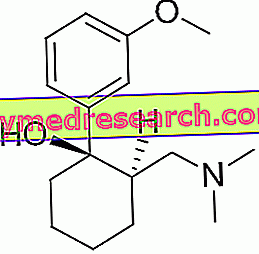Generality
Tramadol is a drug of synthetic origin belonging to the class of opioid painkillers.

Tramadol - Chemical Structure
It is used in the treatment of painful states and is available in pharmaceutical formulations suitable for oral, rectal and parenteral administration.
Tramadol - in addition to interacting with opioid receptors - is also able to inhibit the reuptake of monoamines, such as norepinephrine and serotonin.
Examples of medicinal specialties containing Tramadol
- Adamon ®
- Contramal ®
- Fortradol ®
- Patrol ® (in association with paracetamol).
- Prontalgin ®
- Tradonal ®
Indications
For what it uses
The use of tramadol is indicated for the treatment of moderate to severe pain of different origin and nature, including pain caused by surgery or diagnostic tests.
Warnings
Before starting any tramadol therapy, you must inform your doctor if you are in one of the following conditions:
- If you are - or have been - addicted to other drugs;
- If you are suffering from brain diseases, as the drug could make them worse;
- If you are suffering from liver and / or kidney diseases;
- If you suffer from respiratory depression
Tramadol can cause convulsions, therefore its use should be carried out with great caution in epileptic patients, in patients suffering from convulsive disorders and in patients taking drugs capable of lowering the seizure threshold.
The use of tramadol - especially if for long periods - can lead to the onset of physical and mental dependence. Should this occur, you should immediately contact the doctor who will take all appropriate measures to counter this side effect.
Tramadol should not be used in patients who have had drug addiction, as it can cause relapses.
The use of tramadol should be done with caution even in patients at risk of suicide and in patients on antidepressant medication.
Because tramadol is able to inhibit serotonin reuptake, it can cause a very dangerous side effect known as serotonin syndrome. Therefore, should any of the typical symptoms of the aforementioned syndrome appear (see the "Side effects" section), it is necessary to stop the treatment with the drug and immediately contact the doctor.
During treatment with tramadol, alcohol intake should be avoided as it may increase the effects of the drug.
Tramadol may decrease the state of vigilance, therefore, it may alter the ability to drive vehicles and / or use machinery. Therefore, these activities should be avoided during treatment with the drug.
Interactions
Tramadol should not be used by patients who are taking - or have taken in the last two weeks - monoamine oxidase inhibitors (or MAOIs, drugs used to treat Parkinson's disease and depression). This is because of the dangerous side effects that can arise.
The concomitant administration of MAOIs, triptans (drugs used in the treatment of migraine) and SSRIs (selective serotonin reuptake inhibitors, antidepressant drugs) may promote the occurrence of serotonin syndrome.
Concomitant administration of tramadol and partial agonists or opioid receptor antagonists (such as buprenorphine, naloxone and naltrexone ) should be avoided, as withdrawal symptoms may occur.
Also, before starting tramadol treatment, you need to tell your doctor if you are already taking any of the following medications:
- Antidepressants or antipsychotics, as these medicines lower the seizure threshold and concomitant administration with tramadol could favor the onset of convulsions;
- Other opioid analgesics ;
- Hypnotic and anxiolytic sedative drugs, as they can increase the effects of tramadol;
- Oral anticoagulants, such as warfarin, because tramadol can increase its effect causing bleeding.
The pain-relieving effect of tramadol can be reduced by concomitant administration of the following drugs:
- Carbamazepine, an antiepileptic;
- Fluoxetine and paroxetine (SSRI drugs);
- Quinidine, an antiarrhythmic;
- Digoxin, used to increase the strength of cardiac contraction;
- Ritonavir, an antiviral used in the treatment of HIV;
- Cimetidine, a drug used to reduce acid secretion of the stomach;
- Ondansetron, an antiemetic.
However, it is still advisable to inform your doctor if you are taking - or have recently been - any type of medication, including prescription-free medicines and herbal and homeopathic products.
Side effects
Tramadol can cause different types of side effects, although not all patients experience them. This depends on the different sensitivity that each individual has towards the drug.
The main side effects that may occur during treatment with tramadol are listed below.
Allergic reactions
Tramadol can trigger allergic reactions in sensitive individuals. These reactions can occur with:
- Angioedema;
- bronchospasm;
- Bronchial wheezing;
- Dyspnoea;
- Anaphylaxis.
Serotonin syndrome
Serotonin syndrome may occur during tramadol therapy, especially when the drug is taken concomitantly with MAOIs, SSRIs or triptans.
The typical symptoms of this dangerous syndrome are:
- Temperature;
- Confusion and agitation;
- Hallucinations;
- Sweating;
- Ataxia;
- hyperreflexia;
- incoordination;
- myoclonus;
- Tachycardia;
- Hyperthermia;
- Nausea, vomiting and diarrhea.
Nervous system disorders
Treatment with tramadol can cause:
- Drowsiness;
- Headache;
- Dizziness;
- Tremors;
- paresthesia;
- Speech disorders;
- Convulsions.
Psychiatric disorders
Tramadol-based therapy can promote the onset of:
- Euphoria or dysphoria;
- Hallucinations;
- Confusion;
- Sleep disorders;
- Nightmares;
- Delirium;
- Anxiety.
Cardiovascular disorders
During treatment with tramadol may occur:
- Flushing;
- Hypertension;
- Bradycardia or tachycardia;
- Palpitations;
- Cardiovascular collapse.
Gastrointestinal disorders
In the course of tramadol therapy, the following may occur:
- Nausea and vomit;
- Constipation;
- Gastrointestinal irritation.
Skin and subcutaneous tissue disorders
Treatment with tramadol can cause increased sweating, hives, itching and rash.
Lung and respiratory tract disorders
Tramadol therapy can cause worsening of asthma in affected patients, difficulty breathing or wheezing and may promote the onset of respiratory depression.
Other side effects
Other side effects that may occur during tramadol therapy are:
- Physical and psychic dependence;
- Dry mouth;
- Blurry view;
- Fatigue;
- Muscle weakness;
- Pain when urinating and / or difficulty urinating;
- Changes in appetite;
- Increased values of liver enzymes.
Overdose
In the event of intake of excessive doses of tramadol may arise:
- Miosi;
- Nausea or vomiting;
- Drowsiness;
- dizziness;
- Hypotension;
- Tachycardia;
- Collapse;
- Decrease of consciousness until reaching the coma;
- Convulsions;
- Breathing difficulties up to respiratory arrest.
If tramadol overdose is suspected, contact your doctor immediately or go to the nearest hospital.
Action mechanism
Tramadol exerts its pain-relieving action by acting on opioid receptors (especially on the μ receptors) present in the body.
These receptors are located along the pain pathways and their task is to modulate the neurotransmission of the pain stimulus. More precisely, when opioid receptors are stimulated, a cascade of chemical signals is triggered which eventually leads to the induction of analgesia.
Tramadol - as an agonist of the aforementioned receptors - is able to activate them thus exerting a pain-relieving action.
Despite this, the opioid activity of tramadol is decidedly lower than that of other painkillers belonging to its class. However, the interaction with μ receptors is not the only mechanism by which this drug carries out its activity, in fact, tramadol is also able to inhibit the reuptake of serotonin and noradrenaline.
This other mechanism of action also seems to be involved in reducing the perception of pain.
Mode of Use - Posology
Tramadol is available for:
- Oral administration in the form of prolonged-release tablets, oral drops, hard capsules, effervescent tablets, oral solution and orodispersible tablets.
- Rectal administration in the form of suppositories.
- Intramuscular, subcutaneous or intravenous administration as an injectable solution.
To avoid the occurrence of dangerous adverse reactions, during treatment with tramadol, it is essential to scrupulously follow the instructions provided by the doctor, both as regards the amount of drug to be taken, both as regards the frequency of administration and the duration of the same treatment.
However, some indications are given below on the doses of tramadol usually used in therapy.
Generally, treatment with tramadol begins with an initial dose of 50-100 mg of drug, depending on the intensity of the pain that afflicts each patient. If necessary, the doctor may decide to gradually increase the amount of drug administered, taking care never to exceed the maximum daily dose of 400 mg.
In elderly patients and in patients with hepatic and / or renal diseases, adjustment of the tramadol dosage usually employed may be necessary.
Pregnancy and breastfeeding
Tramadol can cause respiratory depression and withdrawal syndrome in newborns whose mothers took the drug during pregnancy. Therefore, its use during gestation is not recommended.
Furthermore, tramadol is excreted in breast milk, therefore, even in breast-feeding women, the use of the drug is not recommended.
Contraindications
The use of tramadol is contraindicated in the following cases:
- In patients with known hypersensitivity to the same tramadol;
- In patients with acute alcohol poisoning, hypnotic sedatives, painkillers or other psychotropic drugs;
- In patients taking - or who have recently taken - monoamine oxidase inhibitor drugs;
- In patients with uncontrolled epilepsy;
- In substitution treatment of drug cessation;
- In children under 12 years of age;
- Pregnant;
- During breastfeeding.



